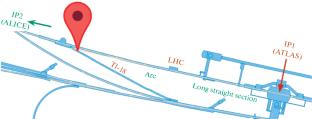2025年及以后的SND@LHC
IF 0.4
4区 物理与天体物理
Q4 PHYSICS, NUCLEAR
引用次数: 0
摘要
SND@LHC(大型强子对撞机的散射和中微子探测器)实验研究了大型强子对撞机在\(7.2<\eta<8.6\)伪快度范围内产生中微子的过程。探测器包括一个质量为830千克的目标,由散布着乳剂和电子探测器的钨板组成,其后是一个强子量热计和一个介子探测系统。这种探测器结构提供了一种独特的可能性,可以在大型强子对撞机的其他实验无法达到的伪快区内研究粲子产生。本研究叙述了实验的现代状况及其对不久将来的展望。本文章由计算机程序翻译,如有差异,请以英文原文为准。

SND@LHC in 2025 and Beyond
The SND@LHC (Scattering and Neutrino Detector at the Large Hadron Collider) experiment studies processes involving neutrinos generated at the LHC in the pseudorapidity range of \(7.2<\eta<8.6\). The detector includes a target having a mass of 830 kg and consisting of tungsten plates interspersed with emulsion and electronic detectors, which is followed downstream by a hadronic calorimeter and a muon-detecting system. The detector structure provides a unique possibility for studying charm production in the pseudorapidity region inaccessible to other experiments at the LHC. The modern state of the experiment and its prospects for the near future are described in the present study.
求助全文
通过发布文献求助,成功后即可免费获取论文全文。
去求助
来源期刊

Physics of Atomic Nuclei
物理-物理:核物理
CiteScore
0.60
自引率
25.00%
发文量
56
审稿时长
3-6 weeks
期刊介绍:
Physics of Atomic Nuclei is a journal that covers experimental and theoretical studies of nuclear physics: nuclear structure, spectra, and properties; radiation, fission, and nuclear reactions induced by photons, leptons, hadrons, and nuclei; fundamental interactions and symmetries; hadrons (with light, strange, charm, and bottom quarks); particle collisions at high and superhigh energies; gauge and unified quantum field theories, quark models, supersymmetry and supergravity, astrophysics and cosmology.
 求助内容:
求助内容: 应助结果提醒方式:
应助结果提醒方式:


